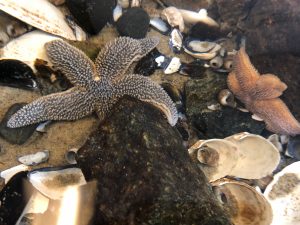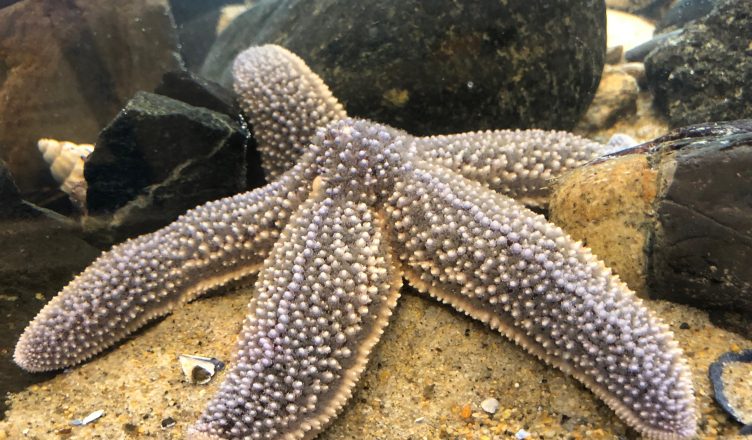This is part of our series about different animals and events at our Blue Ocean Discovery Center. This month we will discuss a Discovery Center favorite: the starfish or sea star.
For hundreds of years, the star-shaped ocean animal was called a starfish; but because it is not a fish, marine scientists have changed the name to sea star.
A Keystone Species
Sea stars are important members of the marine environment and are considered a keystone species. A keystone species preys on animals that have no other natural predators and if they are removed from the environment, their prey will increase in number and may drive out other species. A keystone species has a very large effect on an ecosystem. For example: seas tars prey on mussels and if the sea stars are removed from the environment, the mussel population will greatly increase and other organisms may have difficulty living in that environment.
Sea Star Anatomy
When asked to describe a sea star, most people would say that it’s an animal with five arms that surround a central disc. The stars commonly found in the Hampton area usually do have five arms but sea stars may also have six, seven, ten to fifteen, or even fifty arms.
If you look carefully, you should find a wart like structure on the top of the sea star. That is the sieve plate or madreporite and it’s where water enters the sea star’s body for use in the water vascular system which helps the star move.
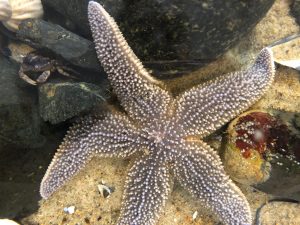
Like their relatives the sea urchins, sea stars are covered with spines but the star’s spines are much shorter than the urchin’s. The spines protect the stars from most predators but some crabs, fish and gulls do attack the sea stars. The sea stars in our tanks usually survive quite well, but when we observed our lobster trying to eat a star, we rescued it!
When you turn a sea star over, you should be able to see the tube feet. They are used for movement. Be sure to watch the Discovery Center stars moving on the sides of the observation tanks. A very observant visitor will see the red eyespot on the end of each of the star’s arms. The sea star can see shadows with their eyespots.
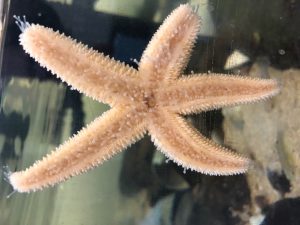
What Do Sea Stars Eat?
Sea stars eat bivalves, fish and snails and we stock the tanks with plenty of mussels and clams for them to dine on. The sea star climbs onto a clam and using its tube feet, it attaches to the clam’s shells and pulls on the shells until the clam weakens and opens the shells. When there is an opening, the sea star everts its clear, baglike stomach into the space and onto the clam’s body. It then secretes digestive enzymes onto the clam, slurps up the semi-digested clam and stomach, and finishes digestion back inside its body. Be sure to look for feeding sea stars in the Discovery Center.
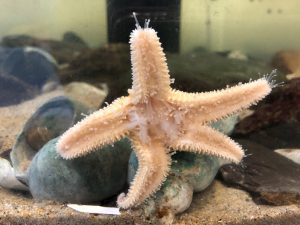
Regenerating Lost Arms
Most people know that sea stars are capable of regenerating a lost arm. Scientists are studying them to see if humans could some day also regenerate lost body parts. But why did the sea star lose the arm to begin with? Sea stars are capable of self-amputation or autotomy as a means of self defense. If a predator pulls on an arm, the sea star will drop it off and attempt to get away from the attacker. Be very careful when handling sea stars because if you hold them by just one arm, they will self-amputate and drop the arm off of their body. Regeneration can take months to years to complete.
Sea Star Wasting Disease
Sea stars have recently been afflicted with a disease called sea star wasting disease (SSWD). The disease was first noticed on the North American west coast, but it is now on the east coast as well. Melina Giakoumas, a PhD student at the City College of NY, recently spoke at our Spring Marine Science Workshop and told us that she is using genomics to study populations and to make predictions about the future of the species, the effects of SSWD, and the far reaching effects on the east coast intertidal ecosystem. She sampled the Discovery Center sea stars and they will become part of her research.
Finding Sea Stars
People always ask where we find our sea stars and we are hesitant to reveal our hunting grounds because we don’t want them collected for souvenirs. We take only a few every year for our observation tanks and leave the biggest ones to reproduce. We know that sea stars are a favorite decoration but encourage people to purchase artificial stars rather than kill the few that remain in the environment.
